Canon ELPH320HSSIL, ELPH320HSBLK, ELPH320HSBLUE User Manual
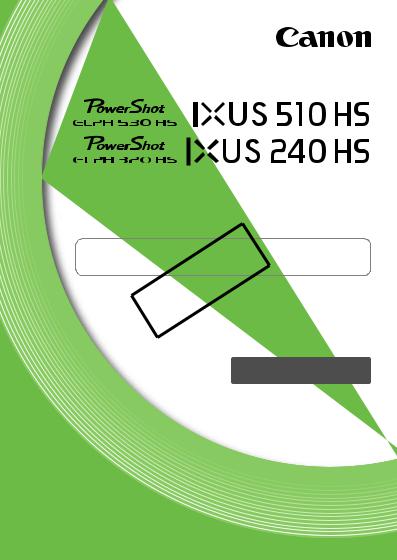
Getting Started
Please refer to the complete user guide included
on the |
COPY |
|
• Before use, be sure to read this guide, including the safety precautions.
• This guide will familiarize you with how to use the camera correctly.
• Keep the guide handy for future reference.
ENGLISH
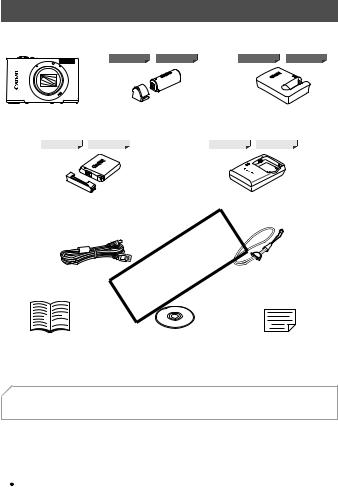
 Package Contents
Package Contents
Before use, make sure the following items are included in the package. If anything is missing, contact your camera dealer.
ELPH 530 HS IXUS 510 HS ELPH 530 HS IXUS 510 HS
Camera |
Battery Pack NB-9L |
|
|
|
Battery Charger |
|
(with terminal cover) |
|
|
|
CB-2LB/CB-2LBE |
ELPH 320 HS |
IXUS 240 HS |
ELPH 320 HS |
IXUS 240 HS |
||
Battery Pack NB-11L |
|
Battery Charger |
|||
(with terminal cover) |
|
CB-2LD/2LDE |
|||
|
COPY |
Wrist Strap |
|||
Interface Cable |
|
|
|||
IFC-400PCU |
|
|
WS-DC10 |
||
|
|
|
|
||
Getting Started |
DIGITAL CAMERA |
|
|
Warranty |
|
|
Solution Disk |
|
|
|
Card |
• A memory card is not included (p. 3).
About Getting Started (This Guide) and the PDF
Manuals
This guide introduces basic camera operations.
To master more advanced operations and use the included software, refer to the PDF manuals on the CD-ROM (p. 31).
 • Adobe Reader is required to view the PDF manuals.
• Adobe Reader is required to view the PDF manuals.
2
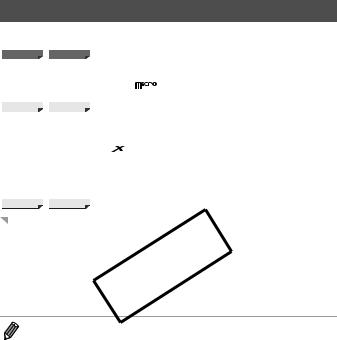
 Compatible Memory Cards
Compatible Memory Cards
The following memory cards (sold separately) can be used, regardless of capacity.
ELPH 530 HS |
IXUS 510 HS |
•microSD memory cards*
•microSDHC memory cards*
•microSDXC memory cards*

ELPH 320 HS |
IXUS 240 HS |
•SD memory cards*
•SDHC memory cards*
•SDXC memory cards* 
•Eye-Fi cards
*Conforms to SD specifications. However, not all memory cards have been verified to work with the camera.
ELPH 320 HS IXUS 240 HS
About Eye-Fi Cards
This product is not guaranteed to support Eye-Fi card functions (including wireless transfer). In case of an issue with an Eye-Fi card, please check with the card manufacturer. COPY
Also note that an approval is required to use Eye-Fi cards in many countries or regions. Without approval, use of the card is not permitted. If it is unclear whether the card has been approved for use in the area, please check with the card manufacturer.
• Always confirm beforehand that memory cards are supported on other devices such as card readers and computers (including the current version of your operating system).
3

 Preliminary Notes and Legal
Preliminary Notes and Legal
Information
•Take and review some test shots initially to make sure the images were recorded correctly. Please note that Canon Inc., its subsidiaries and affiliates, and its distributors are not liable for any consequential damages arising from any malfunction of a camera or accessory, including memory cards, that results in the failure of an image to be recorded or to be recorded in a way that is machine readable.
•Images recorded by the camera are intended for personal use. Refrain from unauthorized recording that infringes on copyright law, and note that even for personal use, photography may contravene copyright or other legal rights at some performances or exhibitions, or in some commercial settings.
•The camera warranty is valid only in the area of purchase. In case of camera problems while abroad, return to the area of purchase before contacting a Canon Customer Support Help Desk.
•Although the LCD monitor is produced under extremely high-precision manufacturing conditions and more than 99.99% of the pixels meet design specifications, in rare cases some pixels may be defective or may appear
as red or black dots. This does not indicate camera damage or affect recorded images. COPY
•The LCD monitor may be covered with a thin plastic film for protection against scratches during shipment. If covered, remove the film before using the camera.
•When the camera is used over an extended period, it may become warm. This does not indicate damage.
Table of Contents |
|
Package Contents ................................................................................. |
2 |
Compatible Memory Cards .................................................................... |
3 |
Preliminary Notes and Legal Information............................................... |
4 |
Safety Precautions................................................................................. |
5 |
Part Names and Conventions in This Guide.......................................... |
8 |
Touch-Screen Operations.................................................................... |
10 |
Initial Preparations ............................................................................... |
11 |
Trying the Camera Out ........................................................................ |
20 |
Included Software, PDF Manuals ........................................................ |
25 |
Accessories ......................................................................................... |
32 |
Specifications....................................................................................... |
33 |
Wireless LAN Guide .......................................................................... |
w-1 |
4
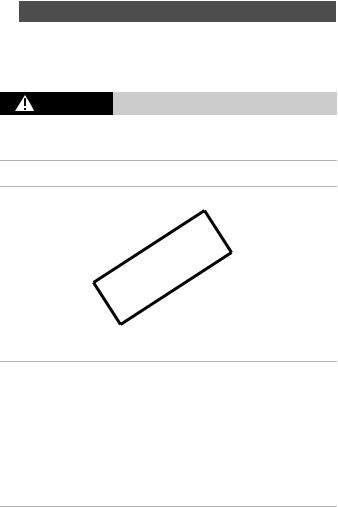
 Safety Precautions
Safety Precautions
•Before using the product, please ensure that you read the safety precautions described below. Always ensure that the product is used correctly.
•The safety precautions noted on the following pages are intended to prevent injuries to yourself and other persons, or damage to the equipment.
•Be sure to also check the guides included with any separately sold accessories you use.
Warning Denotes the possibility of serious injury or death.
• Do not trigger the flash in close proximity to people’s eyes.
Exposure to the intense light produced by the flash could damage eyesight. In particular, remain at least one meter (39 inches) away from infants when using the flash.
•Store this equipment out of the reach of children and infants.
Strap: Putting the strap around a child’s neck could result in asphyxiation.
•Use only recommended power sources.
•Do not attempt to disassemble, alter or apply heat to the product.
•Avoid dropping or subjecting the product to severe impacts.
•To avoid the risk of injury, do not touch the interior of the product if it has been dropped or otherwise damaged.
•Stop using the product immediately if it emits smoke, a strange smell, or otherwise behaves abnormally.COPY
•Do not use organic solvents such as alcohol, benzine, or thinner to clean the product.
•Do not let the product come into contact with water (e.g. sea water) or other liquids.
•Do not allow liquids or foreign objects to enter the camera.
the camera off and remove the battery.
If the battery charger becomes wet, unplug it from the outlet and consult your camera distributor or a Canon Customer Support Help Desk.
•Use only the recommended battery.
•Do not place the battery near or in direct flame.
•Unplug the power cord periodically, and using a dry cloth, wipe away any dust and dirt that has collected on the plug, the exterior of the power outlet, and the surrounding area.
•Do not handle the power cord with wet hands.
•Do not use the equipment in a manner that exceeds the rated capacity of the electrical outlet or wiring accessories. Do not use if the power cord or plug are damaged, or not fully plugged into the outlet.
•Do not allow dirt or metal objects (such as pins or keys) to contact the terminals or plug.
The battery may explode or leak, resulting in electrical shock or fire. This could cause injury and damage the surroundings. In the event that a battery leaks and the battery electrolyte contacts eyes, mouth, skin or clothing, immediately flush with water.
5
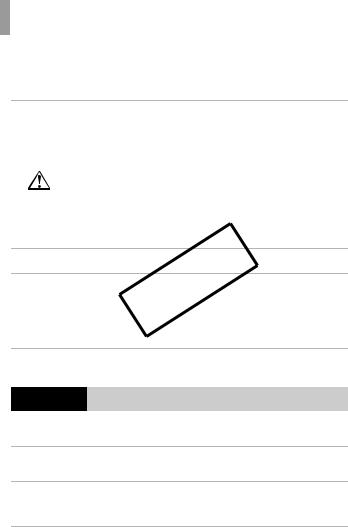
Safety Precautions
• Turn the camera off in places where camera use is prohibited.
The electromagnetic waves emitted by the camera may interfere with the operation of electronic instruments and other devices. Exercise adequate caution when using the camera in places where use of electronic devices is restricted, such as inside airplanes and medical facilities.
•Do not play the supplied CD-ROM(s) in any CD player that does not support data CD-ROMs.
It is possible to suffer hearing loss from listening with headphones to the loud sounds of a CD-ROM played on an audio CD player (music player). Additionally, this could damage the speakers.
Caution |
Denotes the possibility of injury. |
•When holding the camera by the strap, be careful not to bang it, subject it to strong impacts or shocks, or let it get caught on other objects.
•Be careful not to bump or push strongly on the lens.
This could lead to injury or damage the camera.
•When using the flash, be careful not to cover it with your fingers or clothing.
This could result in burns or damageCOPYto the flash.
•Avoid using, placing or storing the product in the following places:
-Places subject to strong sunlight
-Places subject to temperatures above 40 °C (104 °F)
-Humid or dusty areasHigh temperatures may cause deformation of the camera or battery charger casing.
•Viewing images on the camera screen for prolonged periods may cause discomfort.
Caution Denotes the possibility of damage to the equipment.
•Do not aim the camera at bright light sources (such as the sun on a clear day).
Doing so may damage the image sensor.
•When using the camera on a beach or at a windy location, be careful not to allow dust or sand to enter the camera.
This may cause the product to malfunction.
• In regular use, small amounts of smoke may be emitted from the flash.
This is due to the high intensity of the flash burning dust and foreign materials stuck to the front of the unit. Please use a cotton swab to remove dirt, dust or other foreign matter from the flash to prevent heat build-up and damage to the unit.
6

Safety Precautions
• Remove and store the battery when you are not using the camera.
If the battery is left inside the camera, damage caused by leakage may occur.
•Before you discard the battery, cover the terminals with tape or other insulators.
Contacting other metal materials may lead to fire or explosions.
•Unplug the battery charger from the power outlet after charging is complete, or when you are not using it.
•Do not place anything, such as cloth, on top of the battery charger while it is
charging.
Leaving the unit plugged in for a long period of time may cause it to overheat and distort, resulting in fire.
• Do not place the battery near pets.
Pets biting the battery could cause leakage, overheating or explosion, resulting in fire or damage.
• Do not sit down with the camera in your pocket.
Doing so may cause malfunctions or damage the screen.
• When putting the camera in your bag, ensure that hard objects do not come into contact with the screen.
• Do not attach any hard objects to the camera.
Doing so may cause malfunctionsCOor damagePYthe screen.
7

 Part Names and Conventions in This
Part Names and Conventions in This
Guide
ELPH 530 HS |
|
|
IXUS 510 HS |
|||||||||||
|
|
|
|
|
|
|
|
|
|
|
|
|
|
|
|
|
|
|
|
|
|
|
|
|
|
|
|
|
|
|
|
|
|
|
|
|
|
|
|
|
|
|
|
|
|
|
|
|
|
|
|
|
|
|
|
|
|
|
|
|
|
|
|
|
|
|
|
|
|
|
|
|
|
|
|
|
|
|
|
|
|
|
|
|
|
|
|
|
|
|
|
|
|
|
|
|
|
|
|
|
|
|
|
|
|
|
|
|
|
|
|
|
|
|
|
|
|
|
|
Lens |
|
|
Microphone |
Wireless LAN indicator |
|
Speaker |
|
Zoom lever |
|
|
Battery cover |
Shooting: i |
|
COPY |
|
(telephoto) / j(wide |
DC coupler terminal cover |
||
angle) |
|
|
Tripod socket |
Playback: k(magnify) / g(index) |
Screen (LCD monitor) |
||
Shutter button |
|
Memory card cover |
|
Indicator |
|
|
Strap mount |
1(Playback) button |
|
HDMITM terminal |
|
Power button |
|
|
AV OUT (Audio/video output) / DIGITAL |
Lamp |
|
|
|
|
|
terminal |
|
Flash |
|
|
|
•In this guide, icons are used to represent the corresponding camera buttons and switches on which they appear or which they resemble.
•On-screen text is indicated in brackets.
• : Important information you should know
: Important information you should know
• : Notes and tips for expert camera use
: Notes and tips for expert camera use
•(p. xx): Pages with related information (in this example, “xx” represents a page number)
•Instructions in this guide apply to the camera under default settings.
•For convenience, all supported memory cards are simply referred to as “the memory card”.
8
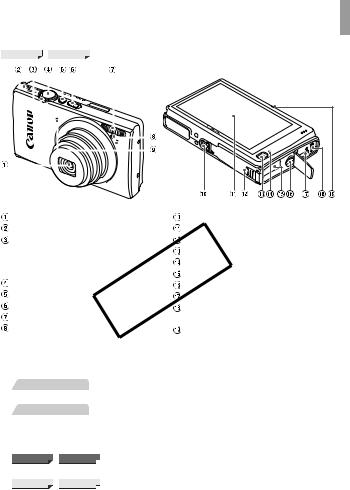
Part Names and Conventions in This Guide
ELPH 320 HS |
|
IXUS 240 HS |
|
||||||||||
|
|
|
|
|
|
|
|
|
|
|
|
|
|
|
|
|
|
|
|
|
|
|
|
|
|
|
|
|
|
|
|
|
|
|
|
|
|
|
|
|
|
|
|
|
|
|
|
|
|
|
|
|
|
|
|
|
|
|
|
|
|
|
|
|
|
|
|
|
|
|
|
|
|
|
|
|
|
|
|
|
|
|
|
|
|
|
|
|
|
|
|
|
|
|
|
|
|
|
|
|
|
|
|
|
|
|
|
|
|
|
|
|
|
|
|
|
|
|
|
|
|
|
|
|
|
|
|
|
|
|
|
|
|
|
|
|
|
|
|
Lens |
|
Tripod socket |
Speaker |
|
Screen (LCD monitor) |
Zoom lever |
|
Memory card/battery cover |
Shooting: i(telephoto) / j(wide |
1(Playback) button |
|
angle) |
COPY |
|
|
Indicator |
|
Playback: k(magnify) / g(index) |
DC coupler cable port |
|
Shutter button |
|
Strap mount |
Power button |
|
HDMITM terminal |
Mode switch |
|
AV OUT (Audio/video output) / DIGITAL |
Flash |
|
terminal |
Lamp |
|
Wireless LAN indicator |
|
|
|
 Microphone
Microphone
•The tabs shown above titles indicate whether the function is used for still images, movies, or both.
Still Images : Indicates that the function is used when shooting or viewing still images.
Movies : Indicates that the function is used when shooting or viewing movies.
•The following icons are used to indicate functions that differ depending on the camera model:
ELPH 530 HS |
IXUS 510 HS |
ELPH 320 HS |
IXUS 240 HS |
 : Functions and precautions for the PowerShot ELPH 530 HS/IXUS 510 HS only.
: Functions and precautions for the PowerShot ELPH 530 HS/IXUS 510 HS only.
 : Functions and precautions for the PowerShot ELPH 320 HS/IXUS 240 HS only.
: Functions and precautions for the PowerShot ELPH 320 HS/IXUS 240 HS only.
•This guide uses PowerShot ELPH 530 HS/IXUS 510 HS illustrations and screenshots for all explanations.
9
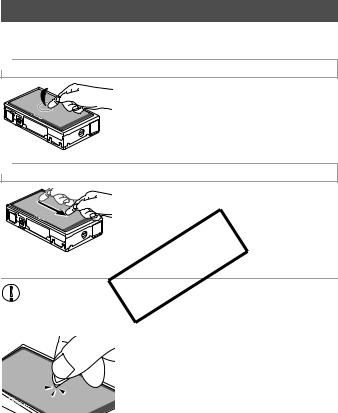
 Touch-Screen Operations
Touch-Screen Operations
The camera’s touch-screen panel enables intuitive operation simply by touching or tapping the screen.
 Touch
Touch
Touch the screen briefly with your finger.
z This gesture is used to shoot, configure camera functions, and so on.
 Drag
Drag
Touch the screen and move your finger across it.
z This gesture is used in Playback mode to switch to the next image, or to change the
COPYmagnified image area, among other operations.
• Gestures may not be detected as easily if you apply a screen protector, because the screen works by detecting finger pressure.
For Easier Touch-Screen Operations
zIf you have difficulty operating the camera by touch, use the stylus attached to the strap. Do not use pencils, pens, or sharp objects other than the included stylus to operate the touch-screen.
To correct any discrepancy between the position you touch and the position detected, calibrate the screen (see Camera User
Guide).
10
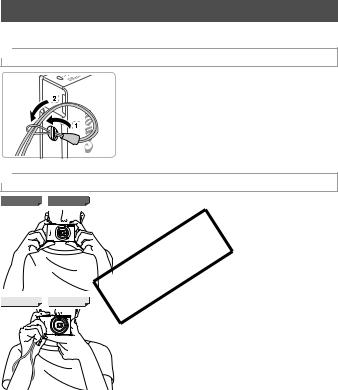
 Initial Preparations
Initial Preparations
Prepare for shooting as follows.
 Attaching the Strap
Attaching the Strap
Attach the strap.
z Thread the end of the strap through the strap hole ( ), and then pull the other end of the strap through the loop on the threaded end (
), and then pull the other end of the strap through the loop on the threaded end (  ).
).
 Holding the Camera
Holding the Camera
ELPH 530 HS |
IXUS 510 HS |
|
|
|
|
ELPH 320 HS |
IXUS 240 HS |
z Place the strap around your wrist.
z When shooting, hold the camera securely to prevent it from moving. Do not rest your fingers on the flash.
COPYz Place the strap around your wrist.
z When shooting, keep your arms close to your body and hold the camera securely to prevent it from moving. Do not rest your fingers on the flash.
11
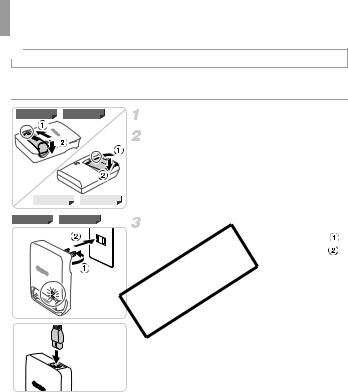
Initial Preparations
 Charging the Battery
Charging the Battery
Before use, charge the battery with the included charger. Be sure to charge the battery initially, because the camera is not sold with the battery charged.
ELPH 530 HS |
IXUS 510 HS |
ELPH 320 HS |
IXUS 240 HS |
|
ELPH 530 HS |
IXUS 510 HS |
|
CB-2LB
Remove the cover.
Insert the battery.
zAfter aligning the Smarks on the battery and charger, insert the battery by pushing it in
(  ) and down (
) and down ( ).
).
Charge the battery.
z For CB-2LB/CB-2LD: Flip out the plug ( |
) |
and plug the charger into a power outlet ( |
). |
COPY |
|
z For CB-2LBE/CB-2LDE: Plug the power |
|
cord into the charger, then plug the other end into a power outlet.
XThe charging lamp turns orange and charging begins.
XWhen the charging is finished, the lamp turns green.
CB-2LBE
12
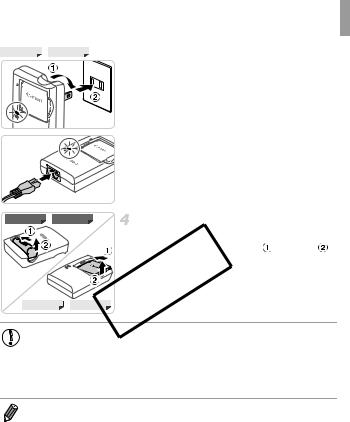
Initial Preparations
ELPH 320 HS |
IXUS 240 HS |
CB-2LD
CB-2LDE
ELPH 530 HS |
IXUS 510 HS |
Remove the battery.
z After unplugging the battery charger, remove the battery by pushing it in ( ) and up ( ).
•To protect the batteryCOPYand keep it in optimal condition, do not charge it continuously for more than 24 hours.ELPH 320 HS IXUS 240 HS
•For battery chargers that use a power cord, do not attach the charger or cord to other objects. Doing so could result in malfunction or damage to the product.
•For details on charging time and the number of shots and recording time possible with a fully charged battery, see “Specifications” (p. 33).
13
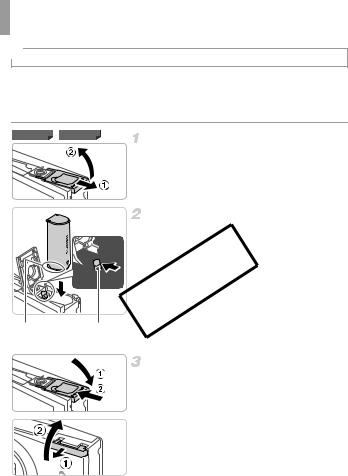
Initial Preparations
 Inserting the Battery and Memory Card
Inserting the Battery and Memory Card
Insert the included battery and a memory card (sold separately).
Note that before using a new memory card (or a memory card formatted in another device), you should format the memory card with this camera (see
Camera User Guide).
ELPH 530 HS |
IXUS 510 HS |
Terminals |
Battery |
|
Lock |
Open the battery cover.
z Slide the cover ( ) and open it (
) and open it ( ).
).
Insert the battery.
z While pressing the battery lock in the direction of the arrow, insert the battery facing as shown and push it in until it clicks
COPYinto the locked position.
z Batteries inserted facing the wrong way cannot be locked into the correct position. Always confirm that the battery is facing the right way and locks when inserted.
Close the battery cover.
z Lower the cover (  ) and hold it down as you slide it until it clicks into the closed position (
) and hold it down as you slide it until it clicks into the closed position (  ).
).
 Open the memory card cover. z Slide the cover (
Open the memory card cover. z Slide the cover ( ) and open it (
) and open it ( ).
).
14
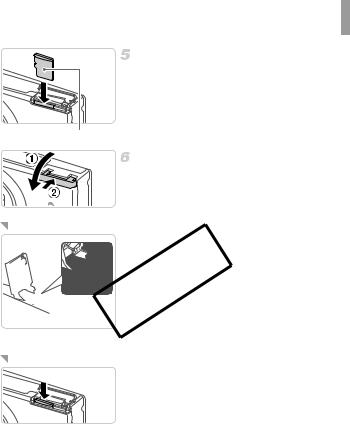
Initial Preparations
Insert the memory card.
z Insert the memory card facing as shown until it clicks into the locked position.
z Make sure the memory card is facing the right
way when you insert it. Inserting memory cards facing the wrong way may damage the
Label camera.
Close the memory card cover.
z Lower the cover (  ) and hold it down as you slide it until it clicks into the closed position (
) and hold it down as you slide it until it clicks into the closed position (  ).
).
Removing the Battery
z Open the cover and press the battery lock in
the direction of the arrow.






 COPYXThe battery will pop up.
COPYXThe battery will pop up.
Removing the Memory Card
zOpen the cover and push the memory card in until it clicks, and then slowly release the
memory card.
XThe memory card will pop up.
15
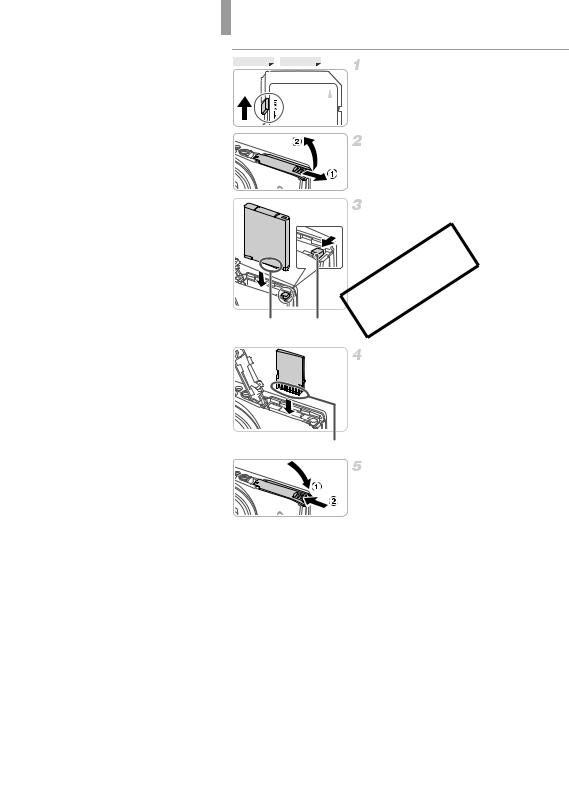
Initial Preparations
ELPH 320 HS |
IXUS 240 HS |
Terminals Battery
Lock
Check the card’s write-protect tab.
zRecording is not possible on memory cards with a write-protect tab when the tab is in the locked (downward) position. Slide the tab up until it clicks into the unlocked position.
Open the memory card/battery cover.
z Slide the cover ( ) and open it (
) and open it ( ).
).
Insert the battery.
z While pressing the battery lock in the direction of the arrow, insert the battery facing as shown and push it in until it clicks
COPYinto the locked position.
z Batteries inserted facing the wrong way cannot be locked into the correct position. Always confirm that the battery is facing the right way and locks when inserted.
Insert the memory card.
z Insert the memory card facing as shown until it clicks into the locked position.
z Make sure the memory card is facing the right
way when you insert it. Inserting memory
cards facing the wrong way may damage the camera.
Terminals
Close the memory card/battery cover.
z Lower the cover (  ) and hold it down as you slide it until it clicks into the closed position (
) and hold it down as you slide it until it clicks into the closed position (  ).
).
16
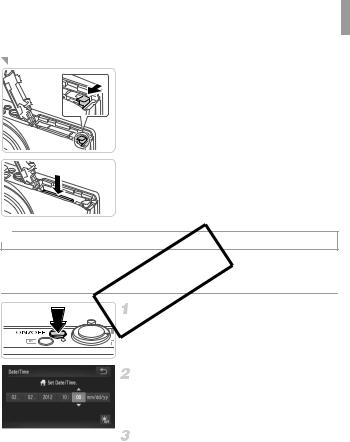
Initial Preparations
Removing the Battery and Memory Card
Remove the battery.
z Open the cover and press the battery lock in
the direction of the arrow. XThe battery will pop up.
Remove the memory card.
z Push the memory card in until it clicks, and then slowly release it.
XThe memory card will pop up.
 Setting the Date and Time
Setting the Date and Time
A screen for setting theCOPYdate and time is displayed the first time you turn the camera on. Be sure to specify the date and time, which is the basis for dates and times added to your images.
Turn the camera on.
z Press the power button.
XThe [Date/Time] screen is displayed.
Set the date and time.
zTouch the option to configure, and then touch opto specify the date and time.
zWhen finished, touch ^.
Finish the setup process.
zOnce the date and time have been set, the [Date/Time] screen is no longer displayed.
zTo turn off the camera, press the power
button.
17
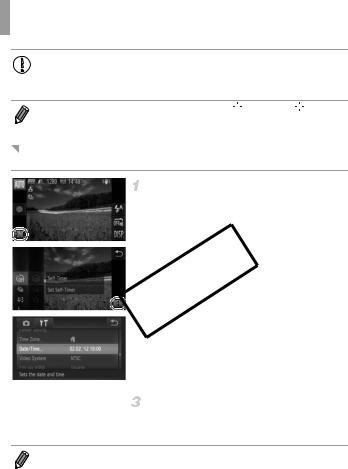
Initial Preparations
• Unless you set the date and time, the [Date/Time] screen will be displayed each time you turn the camera on. Specify the correct information.
• To set daylight saving time (1 hour ahead), touch 

 and choose
and choose 
 in step 2.
in step 2.
Changing the Date and Time
Adjust the date and time as follows.
Access the camera menu.
z Touch H, and then touch n.
COPY hoose [Date/Time].
hoose [Date/Time].
z Touch the 3tab.
z Drag up or down across the screen to choose [Date/Time].
z Touch [Date/Time].
Change the date and time.
zFollow step 2 on p. 17 to adjust the settings.
zDouble-touch ^to close the menu.
•Date/time settings can be retained for about 3 weeks by the camera’s built-in date/time battery (backup battery) after the battery pack is removed.
•The date/time battery will be charged in about 4 hours once you insert a charged battery or connect the camera to an AC adapter kit (sold separately, see Camera User Guide), even if the camera is left off.
•Once the date/time battery is depleted, the [Date/Time] screen will be displayed when you turn the camera on. Follow the steps on p. 17 to set the date and time.
18
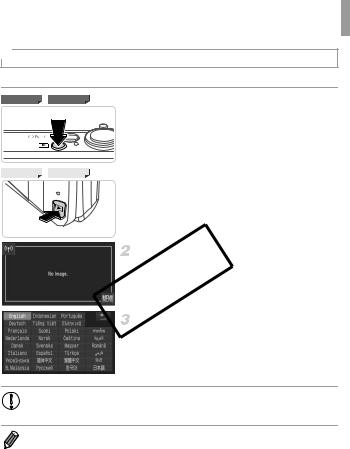
Initial Preparations
 Display Language
Display Language
The display language can be changed as needed.
ELPH 530 HS |
IXUS 510 HS |
ELPH 320 HS |
IXUS 240 HS |
 Enter Playback mode. z Press the 1button.
Enter Playback mode. z Press the 1button.
Access the setting screen.
COPYz Touch and hold nuntil the setting screen is displayed.
Set the display language.
z Touch a display language to choose it, and then touch ^.
XOnce the display language has been set, the setting screen is no longer displayed.
•If there are images on the memory card, touch Hin the lower left to access n.
•You can also change the display language by touching Hand then n,
and then choosing [Language  ] on the 3tab.
] on the 3tab.
19
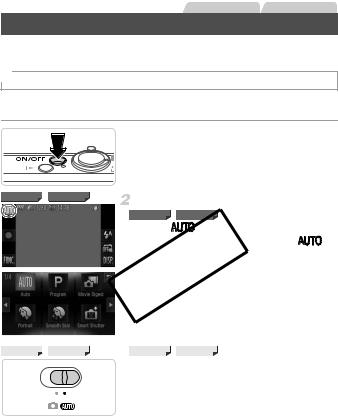
Still Images |
Movies |
 Trying the Camera Out
Trying the Camera Out
Follow these instructions to turn the camera on, shoot still images or movies, and then view them.
 Shooting (Smart Auto)
Shooting (Smart Auto)
For fully automatic selection of the optimal settings for specific scenes, simply let the camera determine the subject and shooting conditions.
 Turn the camera on. z Press the power button.
Turn the camera on. z Press the power button.
XThe startup screen is displayed.
ELPH 530 HS |
IXUS 510 HS |
ELPH 320 HS |
IXUS 240 HS |
Enter Auto mode.
ELPH 530 HS |
IXUS 510 HS |
|
z Touch |
, touch qror quickly drag left or |
|
right on the screen, and then touch |
to |
|
COPY |
|
|
choose it. |
|
|
z To confirm your choice, touch [OK]. |
|
|
ELPH 320 HS |
IXUS 240 HS |
|
z Set the mode switch to A.
20

Trying the Camera Out
z Aim the camera at the subject. As the camera determines the scene, it will make a slight clicking noise.
XA scene icon is displayed in the upper left of the screen and an image stabilization icon in the upper right.
XFrames displayed around any subjects that are detected indicate that they are in focus.
XBlack bars displayed on the left and right edges of the screen indicate image areas not recorded.
Compose the shot.
z To zoom in and enlarge the subject, move the zoom lever toward i(telephoto), and to zoom away from the subject, move it toward
j(wide angle).
COPYShoot.
Shooting Still Images
Focus.
z Press the shutter button lightly, halfway
down. The camera beeps twice after focusing, and AF frames are displayed to
indicate image areas in focus.
AF Frames
21

Trying the Camera Out
Elapsed Time
 Shoot.
Shoot.
zPress the shutter button all the way down.
zAs the camera shoots, a shutter sound is played, and in low-light conditions, the flash
fires automatically.
zKeep the camera still until the shutter sound ends.
XYour shot remains displayed on the screen for about two seconds.
zEven while the shot is displayed, you can take another shot by pressing the shutter button again.
Shooting Movies
 Start shooting.
Start shooting.
z Touch  . The camera beeps once as COPYrecording begins, and [
. The camera beeps once as COPYrecording begins, and [  Rec] is displayed
Rec] is displayed
with the elapsed time.
XThe camera switches to full-screen display, and the portion of your subject shown on the screen is recorded.
XFrames displayed around any faces that are detected indicate that they are in focus.
 Finish shooting.
Finish shooting.
z Touch  . The camera beeps twice as recording stops.
. The camera beeps twice as recording stops.
XRecording will stop automatically when the memory card becomes full.
22

Trying the Camera Out
 Viewing
Viewing
After shooting images or movies, you can view them on the screen as follows.
ELPH 530 HS |
IXUS 510 HS |
Enter Playback mode.
z Press the 1button.
XYour last shot is displayed.
ELPH 320 HS |
IXUS 240 HS |
Browse through your images.
COPYz To view the next image, drag right to left across the screen, and to view the previous image, drag left to right.
z You can also view the next image by touching the right edge of the screen (in the area indicated by frame  at left). In this case, r is displayed. Similarly, you can view the previous image by touching the left edge of the screen (in the area indicated by frame
at left). In this case, r is displayed. Similarly, you can view the previous image by touching the left edge of the screen (in the area indicated by frame 
at left), and in this case, qis displayed.
z Movies are identified by a |
icon. To play |
movies, go to step 3. |
|
Play movies.
z Touch |
to start playback. |
|
z To adjust the volume, quickly drag up or |
||
down across the screen during playback. |
||
XAfter the movie is finished, |
is displayed. |
|
•To switch to Shooting mode from Playback mode, press the shutter button halfway.
23

Trying the Camera Out
Erasing the Images
You can choose and erase unneeded images one by one. Be careful when erasing images, because they cannot be recovered.
Choose an image to erase.
z Drag left or right across the screen to choose an image.
Erase the image.
zTouch H, drag up or down on the screen, and then touch ato choose it.
COPYz After [Erase?] is displayed, touch [Erase]. XThe current image is now erased.
z To cancel erasure, touch [Cancel].
• Images can also be erased by using Touch Actions (see Camera User Guide).
• You can also erase all images at once (see Camera User Guide).
24
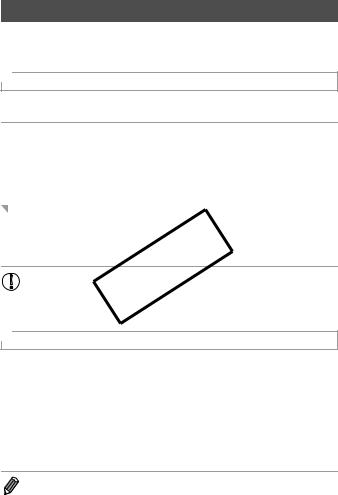
 Included Software, PDF Manuals
Included Software, PDF Manuals
The software and PDF manuals on the included CD-ROM are introduced below, with instructions for installation, saving images to a computer, and using the PDF manuals.
 Features of the Included Software
Features of the Included Software
After installing the software on the CD-ROM, you can do the following things on your computer.
ImageBrowser EX
zImport images and change camera settings
zManage images: view, search, and organize
zPrint and edit images
zUpdate to the latest software version with the auto update function
Auto Update Function
Using the included software, you can update to the latest version, and download new functions via the Internet (some software excluded). Be sure
to |
install the software on a computer with an Internet connection so you can |
|
use |
this |
COPY |
|
||
account
• This function may not be available depending on the camera or region you live in.
 PDF Manuals
PDF Manuals
Installing the software on the CD-ROM will also install the following PDF manuals on your computer.
Camera User Guide
Once you are familiar with the information in Getting Started, refer to this for a more indepth understanding of camera operation.
ImageBrowser EX User Guide
Refer to this guide when using the included software.
This guide can be referenced from the ImageBrowser EX Help function.
•Depending on the country or region where you purchased your camera, the ImageBrowser EX User Guide may not be accessible from the Help function. In such cases, it will either be included on the CD-ROM bundled with your camera, or you can download the latest version from the Canon website.
25
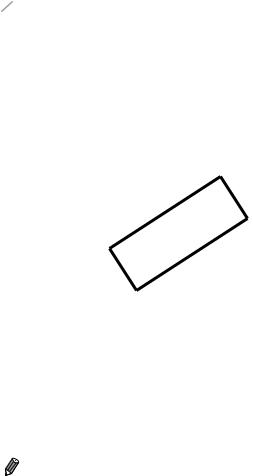
|
|
|
|
|
|
|
|
|
|
|
|
|
|
|
|
|
|
|
|
|
|
|
|
|
|
|
|
|
|
|
|
|
|
|
|
|
|
|
|
|
|
|
|
|
|
|
Interfaces |
USB or wireless LAN |
|
|
|
Free Hard Disk |
|
|
|
|
440 MB or more* |
||
|
|
Space |
||
|
|
|
||
|
|
Display |
|
|
|
|
1024 x 768 resolution or higher |
||
|
|
|
|
|
* In Windows XP, Microsoft .NET Framework 3.0 or later (max. 500 MB) must be installed.
Installation may take some time, depending on computer performance. |
||
Macintosh |
COPY |
|
|
||
Operating System |
Mac OS X 10.6 (Connection via wireless LAN is only supported on |
|
v10.6.8 and later) |
||
|
|
|
Computer |
Computers running one of the above operating systems |
|
(preinstalled), with an included USB port and Internet connection |
||
|
||
|
|
|
Processor |
Core Duo 1.83 GHz or higher (still images), Core 2 Duo 2.6 GHz or |
|
higher (movies) |
||
|
||
RAM |
|
|
1 GB or more (still images), 2 GB or more (movies) |
||
Interfaces |
|
|
USB or wireless LAN |
||
Free Hard Disk |
|
|
550 MB or more |
||
Space |
||
|
||
Display |
|
|
1024 x 768 resolution or higher |
||
|
|
|
|
|
|
•Check the Canon website for the latest system requirements, including supported OS versions.
26
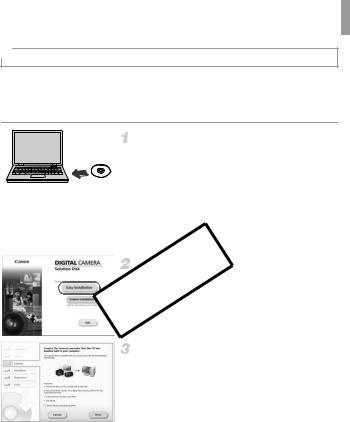
Included Software, PDF Manuals
 Installing the Software and PDF Manuals
Installing the Software and PDF Manuals
Windows 7 and Mac OS X 10.6 are used here for the sake of illustration. Using the software auto update function, you can update to the latest version and download new functions via the Internet (some software excluded), so be sure to install the software on a computer with an Internet connection.
Insert the CD-ROM in the computer’s CD-ROM drive.
z Insert the included CD-ROM (DIGITAL CAMERA Solution Disk) (p. 2) in the computer’s CD-ROM drive.
zOn a Macintosh computer, after inserting the
disc, double-click the desktop disc icon to open it, and then double-click the  icon displayed.
icon displayed.
COPYBegin the installation.
z Click [Easy Installation] and follow the onscreen instructions to complete the installation process.
When a message is displayed prompting you to connect the camera, connect it to a computer.
27

Included Software, PDF Manuals
ELPH 530 HS |
IXUS 510 HS |
ELPH 320 HS |
IXUS 240 HS |
zWith the camera turned off, open the cover (  ). With the smaller plug of the included
). With the smaller plug of the included
interface cable (p. 2) in the orientation shown, insert the plug fully into the camera terminal ( ).
).
z Insert the larger plug of the interface cable in the computer’s USB port. For details about USB connections on the computer, refer to
COPYthe computer user manual.
Install the files.
z Turn the camera on, and follow the on-screen instructions to complete the installation
process.
XThe software will connect to the Internet to update to the latest version and download new functions. Installation may take some time, depending on computer performance
and the Internet connection.
zClick [Finish] or [Restart] on the screen after installation and remove the CD-ROM when the desktop is displayed.
zTurn the camera off and disconnect the
cable.
28
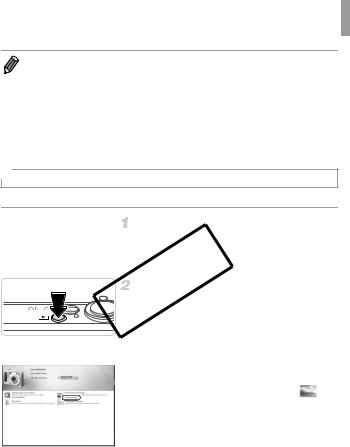
Included Software, PDF Manuals
• When not connected to the Internet, there are the following limitations. - The screen in step 3 will not be displayed.
-Some functions may not be installed.
-The first time you connect the camera to the computer, drivers will be installed, so it may take a few minutes until camera images are accessible.
•If you have several cameras that were bundled with ImageBrowser EX on the included CD-ROMs, be sure to use each camera with their included CD-ROM and follow the on-screen installation instructions for each. Doing so will ensure that each camera will receive the correct updates and new functions via the auto update function.
 Saving Images to a Computer
Saving Images to a Computer
Windows 7 and Mac OS X 10.6 are used here for the sake of illustration.
Connect the camera to the computer.
z Follow step 3 on p. 27 to connect the camera COPYto a computer.
Turn the camera on to access
CameraWindow.
z Press the 1button to turn the camera on.
z On a Macintosh computer, CameraWindow is displayed when a connection is established between the camera and computer.
zFor Windows, follow the steps introduced below.
z In the screen that displays, click the |
link |
to modify the program. |
|
29
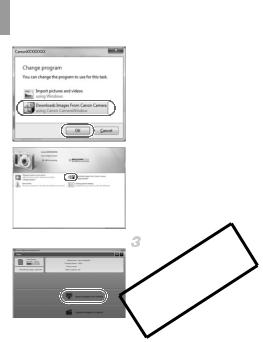
Included Software, PDF Manuals
zChoose [Downloads Images From Canon Camera using Canon CameraWindow] and then click [OK].
zDouble click  .
.
CameraWindow |
Save the images to the computer. |
|
z Click [Import Images from Camera], and then |
|
COPY |
|
click [Import Untransferred Images]. |
|
XImages are now saved to the Pictures folder |
|
on the computer, in separate folders named |
|
by date. |
|
z After images are saved, close CameraWindow, |
|
press the 1button to turn the camera off, and |
|
unplug the cable. |
zFor instructions on viewing images on a computer, refer to the ImageBrowser EX
User Guide.
30
